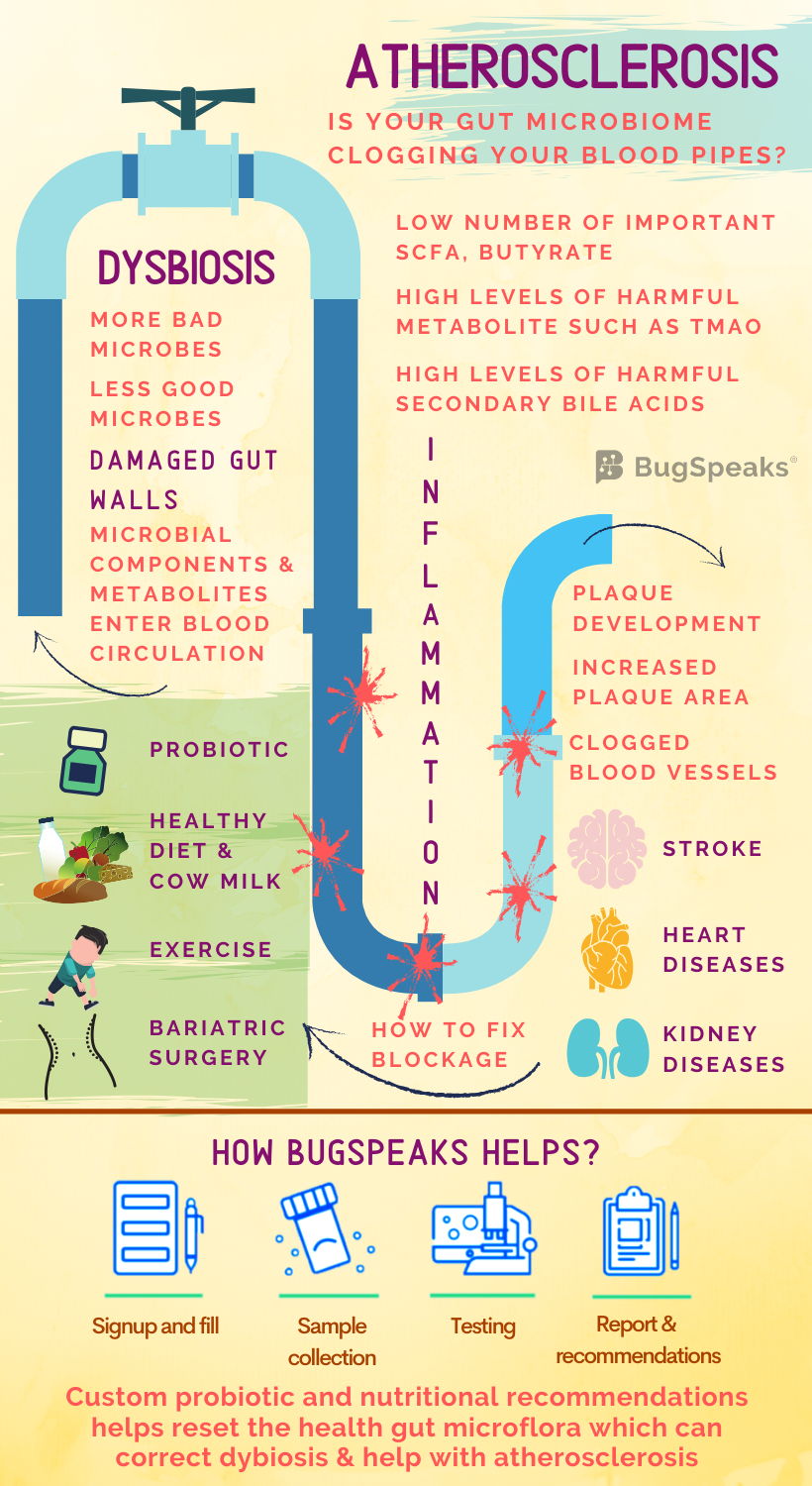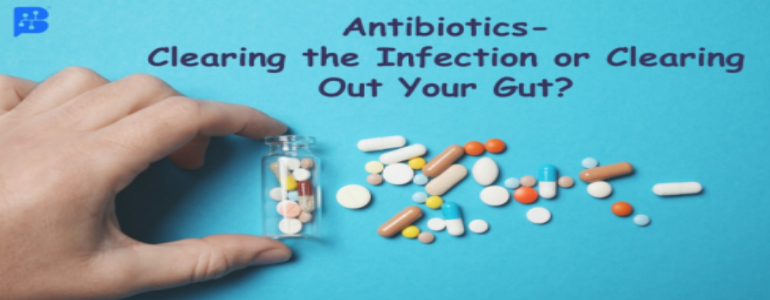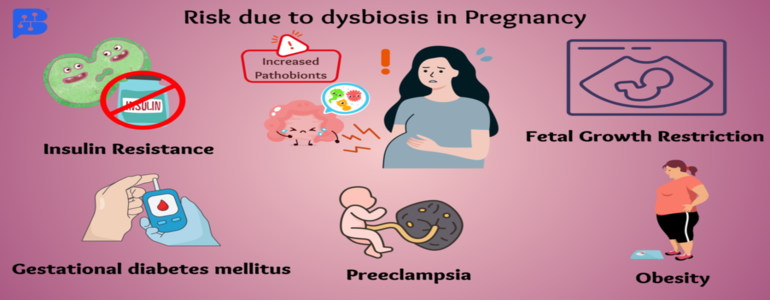- July 10, 2020
- BugSpeaks
- Microbiome and Disease
Gut Microbiome in Atherosclerosis: Unclogging the Bloody Pipes
All the blood in the human body flows through a network of arteries, just like the drainage system in house. When not cleaned regularly, sometimes the pipes in the system get blocked as the dirt and filth collect. Similarly, your arteries may get blocked if not cared for properly, as the fatty matter deposits in them. The arteries become narrow leading to the grave disease called atherosclerosis. So why the arteries get clogged? The sedentary lifestyles are one to blame for.
Moreover, elevated blood cholesterol, high blood pressure, diabetes, obesity, family history, an unhealthy lifestyle, and abnormal gut microbes are blamed for the disease. Yes, you read it right. The microbes residing in your gut, which make up the gut microbiome can also place you at atherosclerosis risk. Your gut microbiome plays a vital role in controlling the metabolism and health of organs. Hence, it is quite relevant to explore the purpose of this diverse ecosystem of microorganisms in causing atherosclerosis.

Gut microbiome dysbiosis: Cause of blockage
Atherosclerosis is a classical chronic inflammatory disease. The healthy gut flora supports lipid (small molecules which makeup fat) metabolism and prevents the development of lesions on arteries. But gut dysbiosis, characterized by maladaptation of gut flora, proves to be a significant player in the event of atherosclerosis. Under this condition, a relatively lower abundance of beneficial microbes such as Roseburia and Eubacterium, and overpopulation of harmful ones such as Collinsella occurs. Not only this, but dysbiosis also damages the gut wall and impairs its integrity. It gives the microbial components like lipopolysaccharide (LPS) and peptidoglycan a chance to escape into the blood circulation and reach arteries. Upon entering the arteries, these components cause inflammation resulting in the development of atherosclerosis9.
What all microbial materials block your arteries?
It is not only the components of gut microbes wreaking havoc in arteries. Specific metabolites produced by gut microbes also control inflammation and atherosclerosis. These metabolites include short-chain fatty acids (SCFAs), methylamines, polyamines, trimethylamine N-oxide (TMAO), and secondary bile acids (BAs). All of them play an essential role in fat metabolism.
SCFAs arise from microbial fermentation of starches and complex dietary fibres in the intestine. Taking part in further metabolic events in the body, the SCFAs inhibit the accumulation of lipid and inflammation in the arterial wall. Also, SFCAs induce secretion of gut hormones, which reduce food intake. But in a dysbiotic gut, butyrate, a critical SCFA occurs in low amounts, as butyrate-producing bacteria such as Roseburia, occur in small numbers. Likewise, the inflammatory insults on the arterial walls increases.
TMAO comes from the oxidation of trimethylamine (TMA), a product of gut microbe activity in the liver. Varying compositions of bacteria pose differential abilities to generate TMAO. Thus, a dysbiotic gut containing higher numbers of TMA-producing bacteria can produce higher levels of TMAO. A higher level of TMAO causes atherosclerosis and larger plaque area. Even low levels of circulating TMAO attenuates atherosclerosis. Studies have found a correlation between TMAO levels and certain human gut microbes’ types. For example, Prevotella finds a relation with high TMAO levels while Bacteroides produce lower levels.
Bile acids (BA) form another group of metabolites produced from cholesterol. BA helps absorb dietary lipids and fat-soluble vitamins. Gut microbiota-derived enzymes convert primary BAs into secondary BAs. Secondary BA influences cholesterol metabolism in host and energy expenditure. But when in a dysbiotic gut, the enzyme activity reduces the gut does not reabsorb secondary BAs that occur in large numbers.
So, these secondary BAs enter the blood circulation, impair elimination of cholesterol, and signal deposition of fats, leading to the development of atherosclerosis. Methanobrevibacter smithii, Clostridium, and Enterococcus find an association with reduced enzyme activity.14 Additionally, the BA receptors in inactivated form inhibit atherosclerosis formation by reducing macrophage inflammation and lipid loading15.
How to manage and correct the blockage??
To correct the blockage, we just need to treat the source, meaning the gut microbiome. If one can restore the balance in the gut, the balance in arteries may also be restored. Therefore, the intestinal microbiome offers a new potential target for the treatment of atherosclerosis.
Probiotics
Just like pouring a cleaning solution down the drainage pipe helps remove collected material, similarly, pouring probiotics in your body can help. Probiotics contain beneficial live microorganisms. Ingestion of viable microorganisms, like, Lactobacillus rhamnosus GR-1, helps hydrolyse bile salts, lower blood cholesterol, and reduce the risk of developing atherosclerosis. In essence, the beneficial microbes can help restore healthy metabolism and removal of plaques in arteries.
Healthy diet
Increased consumption of whole-plant foods, including fruits, vegetables, and wholegrain cereals, helps modulate the gut microbiota. These foods share an inverse correlation with the risk of atherosclerosis development. Antioxidant abundant plant polyphenols prevent the oxidation of low-density lipoprotein. Cranberry extract (CE), a rich source of polyphenols, reduces fatty deposits on arterial walls. Additionally, the intake of CE increases the number of beneficial bacterium Akkermansia. It helps reduce fat storage and the size of plaques.
Intake of fibre-rich wholegrain foods, on the other hand, associates with lower blood glucose and total lipid. Dietary fibres also aid in the proliferation of gut-friendly flora: Bifidobacterium, Lactobacillus, and Enterococcus. Thus, a diet based on healthy foods promotes a happy and healthy microbiome. Strategies that modulate the gut microbiota and their metabolic activities by whole-plant foods, probiotics, and prebiotics may be at the base of healthy eating pyramids. They can decrease the risk of atherosclerosis and related co-morbidities21.
The modern-day diet remains rich in high calorie processed food with high sugar and fat content. While raw and whole food and dietary fibre and fermentable substrates are relatively low, this type of urban diet with high saturated and trans fatty acids relates to the depletion of good metabolic fuels. All this negatively alters the gut microbial profile contributing to increased cholesterol levels. A shift towards a plant-based diet may confer protective effects against atherosclerosis by promoting protective factors and reducing harmful ones.
Cow Milk
Drinking' bovine colostrum', the milk produced by cow up to a few days after the birth of calf remains beneficial. The colostrum contains anti-LPS compounds, which alleviate hyperlipidaemia and atherosclerosis. These compounds also help in healing 'leaky' gut mucosal membranes by removing harmful microbial toxins circulating in the blood. Thus, these compounds reduce local inflammation and prevent disease progression.
Surgery & Exercise
Bariatric procedures, mainly used to lose weight, also help improve obesity-associated metabolic disorders such as atherosclerosis. It also helps in the alteration of the gut microbiota as the body experiences a significant shift in metabolic requirements. Regular physical exercise also alters gut microbial composition. Exercise increases the number of SCFA producing bacteria, thus helping in preventing atherosclerosis and related complication25.
Summing Up
Atherosclerosis is a prevalent disease, and surely, you will accept that the health of your gut microbiome and your lipid metabolism are entangled. So, to cure it, you need a 'Gut Microbiome Test.' It uses sophisticated 'DNA sequencing technology' in stool samples to give a snapshot of the exclusive assortment of microorganisms present in your gut. Then this data will then be used to prepare your individualized diet plan, comprising probiotics, prebiotics, and regular physical exercise. In this way, you can tackle your atherosclerosis.








